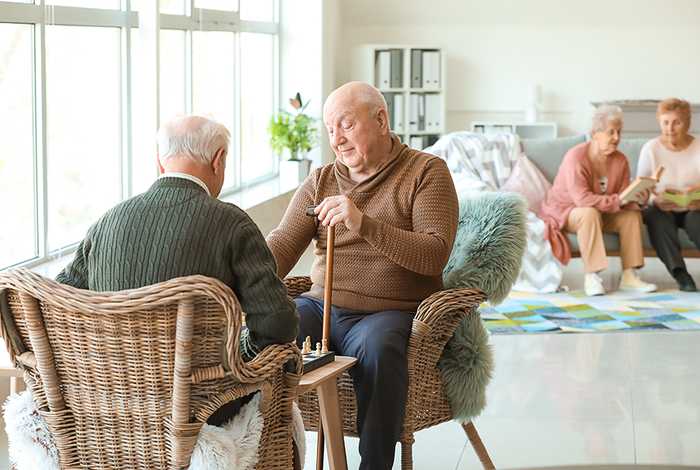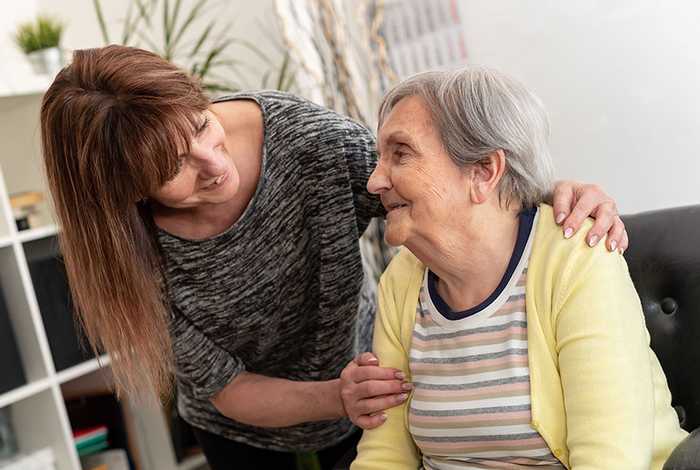Posted by Janine Griffiths
Health and safety in care homes: A complete guide

When it comes to finding the right care home for yourself or a loved one, safety is paramount.
Ensuring a secure and supportive environment is not just about meeting basic needs; it's about providing peace of mind for families and creating a nurturing atmosphere where residents can thrive.
Naturally, when looking at different facilities you want the peace of mind of knowing that either yourself or your loved ones will enjoy a high quality of life that promotes health and wellbeing. Understanding health and safety in care homes involves looking into various aspects, such as regulatory standards, physical infrastructure, hygiene practices, and staff training. It's about knowing what to look for, what questions to ask, and how to ensure that a potential care home meets the highest standards of safety and care.
Whether you are just beginning your search or are in the final stages of choosing a care home, the insights and tips shared here will help you find a safe and caring environment for yourself or your loved one.
Setting the standards for health and safety in care homes
In the UK, regulatory standards and guidelines for care homes are established and enforced by various regulatory bodies, ensuring that care homes meet essential standards of quality and safety.
The Care Quality Commission (CQC) is the regulatory body for England, while in Northern Ireland, it is the Regulation and Quality Improvement Authority (RQIA). In Scotland, the Care Inspectorate is responsible for inspecting care home standards, and in Wales, the Care Inspectorate Wales (CIW) takes on this role.
The CQC and their counterparts in devolved nations ensure that care homes comply with standards covering staff qualifications, resident care, medication management, hygiene practices, and the overall living environment. They also perform a vital role in keeping people who receive health and social care services safe. For more information about the regulatory standards in care homes check out our blog, ‘The Care Quality Commission (CQC) - Demystifying Care Terminology.’
Recent regulatory updates
The landscape of health and safety in care homes is continually evolving, with regulators placing increasing emphasis on accountability and transparency. In recent months, the Health and Safety Executive (HSE) updated its guidance to reflect new best practices, particularly around risk assessments, infection prevention, and fire safety protocols. Meanwhile, scrutiny of the Care Quality Commission (CQC) has intensified, following media reports revealing outdated inspection reports and gaps in oversight. These developments have sparked urgent calls for reform, pushing care homes to remain not only compliant but proactive. Staying up to date with regulatory changes is no longer optional—it's an essential part of maintaining trust and delivering a safe, high-quality environment for residents.
OpenScore
Another valuable tool for assessing the quality of a care home is OpenScore, an independent rating system that provides a score out of ten, helping you make a well-informed decision about the care services you are considering. OpenScore is a data aggregator that assesses a range of factors such as ratings from the aforementioned regulators, infection control measures, plus the environmental, social, and governance (ESG) criteria, among other aspects.
Health and hygiene practices
Ensuring health and safety in care homes is essential for the wellbeing of residents. Care homes should have infection control measures, effective medication management and well established food safety standards to maintain a healthy and safe environment.
Infection control measures: Your loved one’s health is paramount. Look for a care home with robust infection control measures. This includes regular cleaning, proper hand hygiene, and the use of protective equipment. A clean environment not only prevents the spread of illness but also contributes to a positive living experience.
Medication management: Proper medication management is crucial for maintaining good health. Ensure the care home has trained staff to handle medications accurately. Clear procedures for storing, administering, and ordering medicines are essential. Check whether there are documented guidelines about how medications are stored, transported and ordered.
Food safety in care homes: Good nutrition supports overall health and well-being. Choose a care home committed to providing delicious and nutritious meals. Dietary needs and preferences should always be considered. According to the CQC, care homes must assess and fulfill the dietary needs of residents, providing appropriate food and any prescribed nutritional supplements or parenteral nutrition. For more insights into food quality in care homes, check out our blogs: "What standards measure quality in care home food?" and "What ‘good’ looks like: Care home food."
Hygiene: A clean and hygienic environment is essential for a resident's comfort and dignity. Look for a care home with high standards of cleanliness, from bedrooms to communal areas. Choose a care home that maintains rigorous cleaning routines, proper hand hygiene practices, and consistent use of personal protective equipment (PPE).
Physical safety measures
Choosing a care home is a big decision. You want to be sure your loved one is safe, comfortable, and well-cared for. Physical safety is a fundamental aspect of this. Let’s explore some key factors to consider.
Accessibility: A well-designed care home makes life easier. Look for places with ramps, lifts, and easy-to-use exits. You want a home where your loved one can move around freely and confidently.
Fire safety in care homes: Fire safety is crucial. A good care home will have alarms, sprinklers, and clear escape plans. Regular checks on these systems are essential to ensure they're always working properly.
Fall prevention: Falls can be a worry. Look for care homes that have taken steps to prevent them. Things like non-slip floors, good lighting, and helpful equipment such as handrails, grab bars and patient lifts can make a big difference.
Security: You want to feel confident that your loved one is secure. Choose a care home with secure entrances, controlled visitor access, and safe places to keep personal belongings. This will give you peace of mind. Care homes should also have secure, lockable spaces where residents can store their luggage.
Staff training and resident supervision
The ideal care homes should offer a warm and supportive environment where individuals from all backgrounds can enjoy their later years with care and compassion. This is why it is important to have a team of well-trained, empathetic staff members who understand the personal needs of their residents. Staff should undergo regular training in all aspects of resident support to maintain and improve the quality of care provided.
Training and skills of staff
The training and skills of staff is paramount when it comes to improving health and safety in care homes. This training should include fire safety, security, medical monitoring, infection control and food hygiene. It is also important that staff promptly address and investigate incidents and accidents as necessary, promoting an environment of openness and continuous improvement. Care home residents should enjoy a secure and supportive atmosphere while maintaining the freedom to engage in activities of their choice, irrespective of any disabilities or special requirements.
Your loved one’s safety and wellbeing are paramount. We believe care homes should be secure environments where residents can enjoy their lives to the fullest. It's also important that staff know how to respond to emergencies like accidents or health crises.
The ideal care facility will have a home-like atmosphere where everyone feels valued and respected. Residents should have the freedom to choose how they spend their days, regardless of their abilities. Medication is a crucial part of many people’s lives. You should be assured that medicines are handled carefully and securely. We encourage residents to be involved in their medication management as much as possible, helping them maintain independence.
Specialised training programmes in first aid, CPR, and common conditions such as dementia are equally important in order to respond to the health needs of residents quickly.
Resident-to staff ratios
The resident-to-staff ratio in a care home is a crucial factor influencing the quality of care provided. Lower ratios mean that each staff member has fewer residents to care for, allowing for more personalised and attentive support. This can lead to better health outcomes, as caregivers have the time to understand each resident’s individual needs, preferences, and medical requirements.
Adequate staffing levels ensure that employees are not overwhelmed and can maintain a high standard of care. For families seeking a care home, understanding the importance of resident-to-staff ratios can guide them in choosing a facility that provides both the necessary resources and a supportive environment for their loved ones.
Emotional and psychological safety
Robust safeguarding policies and clear reporting mechanisms are essential in protecting residents from potential abuse or neglect. This includes ensuring residents are protected from being bullied, harassed or harmed. Abuse can be either physical, verbal, emotional and financial.
Safeguarding and reporting policies ensure that any concerns are promptly addressed, in order to promote a safe and secure environment.
Resident rights and safeguarding
At the heart of health and safety in care homes is the fundamental principle that every resident has the right to feel safe, respected, and protected. Safeguarding is not a single policy—it’s an ethos that must underpin every aspect of care. From robust whistleblowing procedures to clear reporting pathways for abuse and neglect, safeguarding frameworks are vital for creating a culture of transparency and vigilance. More than ever, care homes must ensure residents are not only physically safe but also emotionally secure, with their dignity and autonomy upheld at every stage of their care journey. Embedding this ethos builds trust, strengthens care standards, and reassures families that their loved ones are in safe hands.
Promoting mental health and wellbeing
Promoting mental health and wellbeing is vital. Care homes may do this in a number of ways. This may include the provision of therapeutic and wellbeing services to support emotional health, such as counselling, group activities, and social events that encourage interaction and build a sense of community. The preferences and mental health of individual patients should also be taken into consideration in a way that respects their individuality and enhances their quality of life.
Technological innovations in safety
Innovation is transforming health and safety in care homes, offering new tools to prevent harm and respond to emergencies faster than ever. Smart monitoring systems, wearable alert devices, and digital care planning software are just some of the technologies reshaping the care environment. These innovations don’t replace the human touch—they enhance it, giving staff real-time insights and freeing up time for more personalised care. For example, motion sensors can detect night-time falls before they become emergencies, and digital records can flag patterns that point to emerging health risks. Technology is no longer a luxury in care—it’s a vital layer of safety that modern care homes can’t afford to ignore.
Final reflections on care home safety
The importance of health and safety in care homes cannot be overstated. From adhering to regulatory standards and investing in staff training, every detail plays a crucial role in creating a secure and supportive environment.
To learn more about the health and safety standards in care homes, it is important to visit the care home and ask a lot of questions. If staff members seem reluctant to answer or there is a lack of transparency, then then it may be a red flag indicating that the facility might not fully meet the expected standards of care and safety. When visiting a care home, be sure to ask questions about staff turnover, emergency procedures, security, and other key aspects of care to ensure the facility meets your expectations for safety and quality.
You should also pay attention to the cleanliness and presentation of the care home in question. Does it look clean and hygienic? Are there hand sanitising stations to prevent the spread of germs? All of these considerations are important when evaluating care home safety. You can also look at the reviews and testimonials associated with the care home in question to gain insights into the experiences of other residents and their families.
The best care homes maintain clear communication and feedback systems, giving residents and families a meaningful role in care and management decisions.
Looking for the best care home?
Autumna offers a free service to provide you with a curated list of care providers in your area, making it easy to compare your options for immediate or future needs. This quick and straightforward process helps you begin your search with confidence.
For personalised assistance with local care services or guidance on funding and benefits, feel free to reach out to our helpful advice team on 01892 335 330.
Receive a Free Care Homes Shortlist!
Let our expert team of advisers get your search off to a great start.
Tell us a little about your needs and we'll send you a bespoke shortlist of care homes! Click the button below to begin, it takes just a few minutes.
Other articles to read
From the blog

Older Persons Care Advice
Care options for the elderly: What is right for you?
October 17th, 2025
Discover care options for the elderly that fit your needs, from home support to residential care, helping you plan confidently for the years ahead.

Older Persons Care Advice
Are next of kin responsible for care home fees
October 17th, 2025
Find out the truth about care costs. Are next of kin responsible for paying care home fees? Learn who pays, exceptions, and how to plan ahead.

Older Persons Care Advice
How to find a live in carer
October 15th, 2025
Discover how to find a live in carer who’s skilled, trustworthy and compatible, with practical tips on choosing the right support for your needs.
Frequently Asked Questions
Common risks include falls, medication errors, infection outbreaks, fire hazards, and inadequate staffing levels. Each of these can have serious consequences if not properly managed, which is why robust health and safety protocols are essential in care settings.
Families should ask about recent inspection reports, staff training programs, infection control measures, and safeguarding policies. Visiting the home, speaking with staff, and checking resources like Autumna’s OpenScore can also provide valuable insights into how seriously the care home takes health and safety.
The Care Quality Commission (CQC) regulates and inspects care homes in England, evaluating their safety, effectiveness, and responsiveness. However, due to recent delays and gaps in reporting, it’s important to look at other up-to-date indicators like provider transparency and resident feedback.
Yes, all care homes must comply with fire safety regulations, including regular risk assessments, staff training, and clearly marked evacuation routes. Failure to meet these standards poses serious risks and can result in legal action or closure.
Technology now plays a key role in preventing accidents and enhancing resident care. From fall detection systems and electronic medication management to digital care planning, these innovations help staff respond faster and more accurately to safety concerns.






